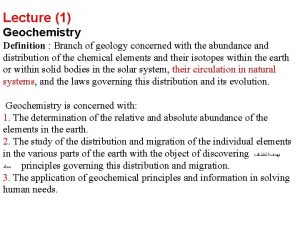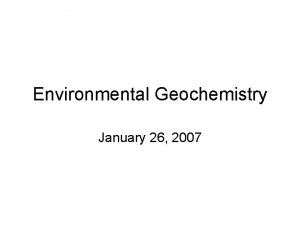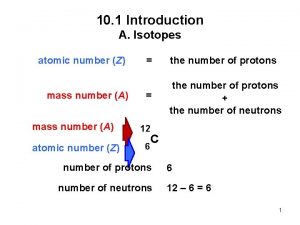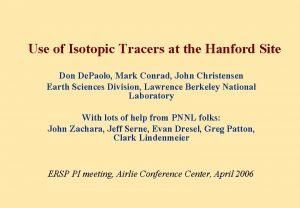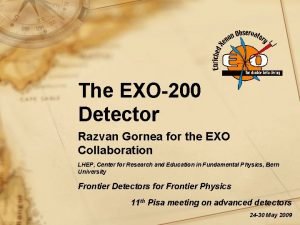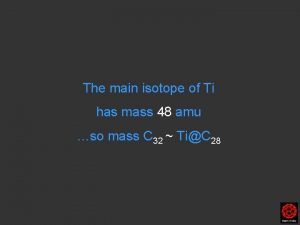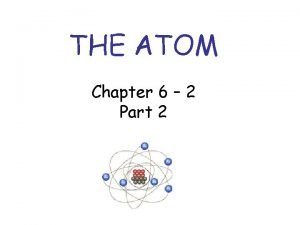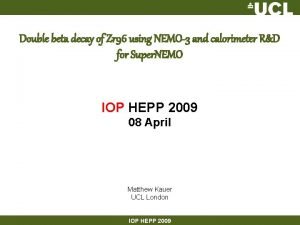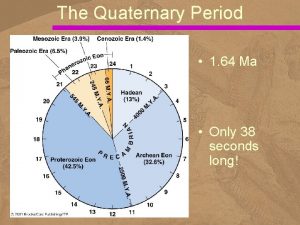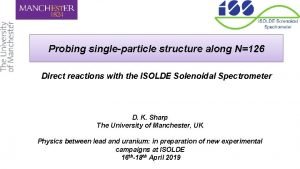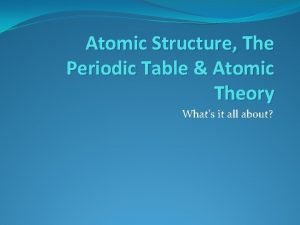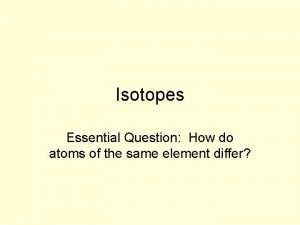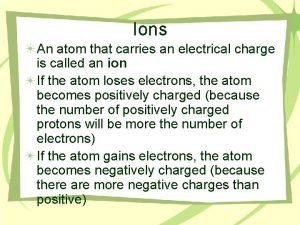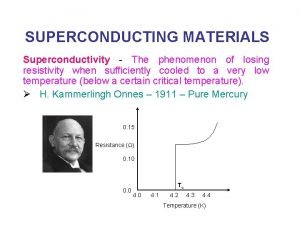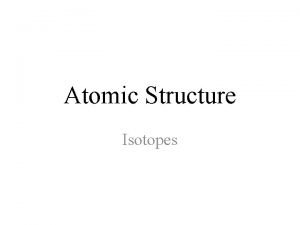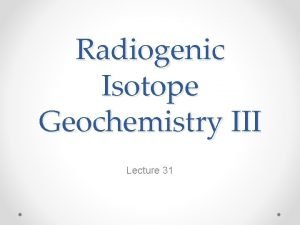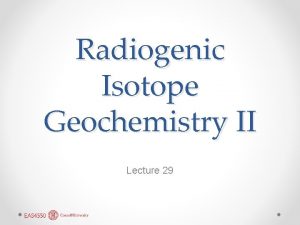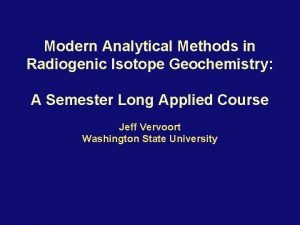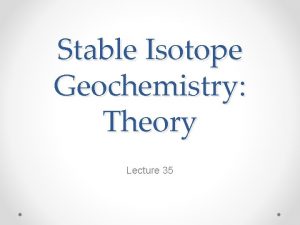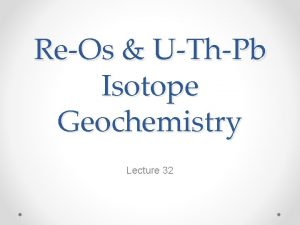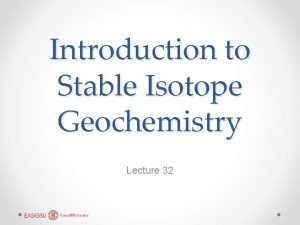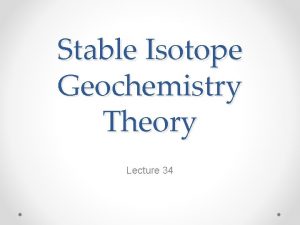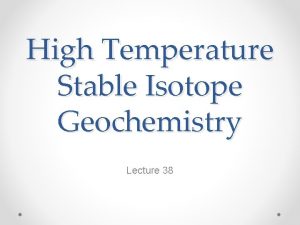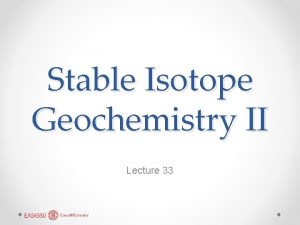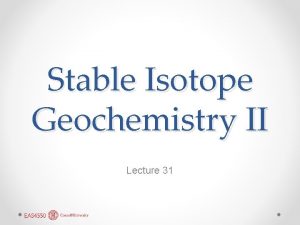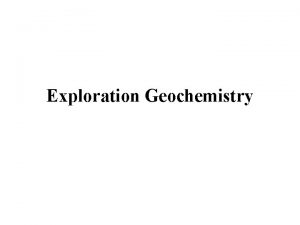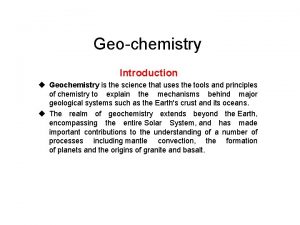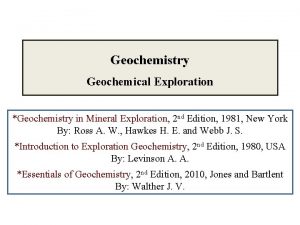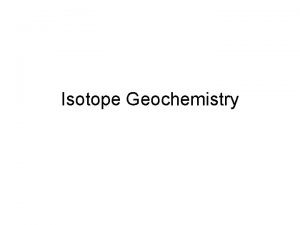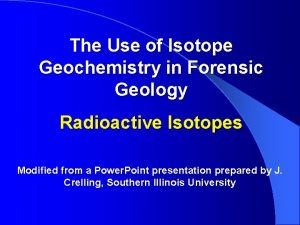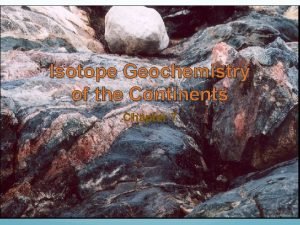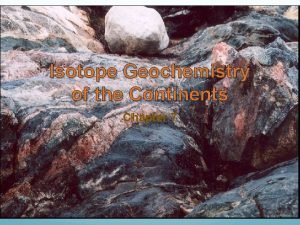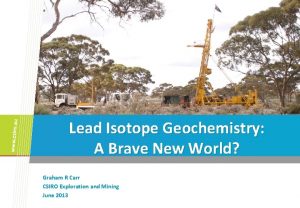Radiogenic Isotope Geochemistry IV Lecture 31 U Th




























- Slides: 28

Radiogenic Isotope Geochemistry IV Lecture 31

U & Th Decay Series Isotopes continued

U and Th Decay Series

234 U-238 U • Dating 234 U is the great-granddaughter of 238 U, and the first long-lived daughter in the chain. We’ll ignoring the two short-lived intermediates (assuming they quickly come to equilibrium). • The half-live of 234 U is 246, 000 yrs, that of 238 U is 4. 47 billion years. On times scales of interest in this system, the abundance (and activity) of 238 U does not change. • The activity of 234 U then can be expressed as: • After long times, the activity ratio will be 1. Before that, it will be a function of time. If we know the initial ratio, we can use it as a geologic clock. • Coral carbonates incorporate U from seawater, which has (234 U/238 U) ≈ 1. 15 (why? ). After many half-lives, the ratio will decline to 1. Hence we can use this to date corals. Unfortunately, (234 U/238 U) hasn’t been exactly constant through time.

230 Th-234 U • • Dating 234 U α-decays to 230 Th (half-life: 75, 000 yrs). Disequilibrium between U and Th is greater than among U isotopes, and in this sense this is a better geochronological tool. We can consider two possibilities: o 234 U and 238 U were also in disequilibrium (e. g. , corals), in which case we much take account of the (234 U/238 U) ratio. o 234 U and 238 U were in equilibrium (volcanic rocks), in which case we can ignore 234 U and treat 230 Th as if it were the direct daughter of 238 U. • For the former case: • This technique has been extensively used for dating corals (which exclude Th, so the ratio on the left starts at close to 0). Because corals also incorporate C, it has been used to calibrate 14 C dates beyond the point where they can be calibrated by dendrochronology. Because reef-building corals live at sealevel, dating of fossil corals has provided a record of sealevel change as the last glacial period ended. This tells us how ice volume changed. It is also used to date carbonates in caves, and by dating ‘spelothem’ coatings on cave painting, constrain the age of the cave paintings. • •

230 Th-238 U • • In volcanic rocks, we can assume 234 U and 238 U are in equilibrium. Here we divide by the activity of the long-lived Th isotope, 232 Th (half-life 14 billion years). It does not decay appreciably on the time scales of interest. The relevant equation is: If we plot a series of cogenetic samples on a (230 Th/232 Th) vs (238 U/232 Th) plot, the slope will be a function of time. Unlike the conventional isochron equation, the intercept is also a function of time. The line pivots around the ‘equipoint’ and after many half-lives will have a slope of 1: the equiline. Dating

Decay Series Summary • Shorter-lived radionuclides have also been used for dating, including 226 Ra (t 1/2 = 1600 yr), 231 Pa (t 1/2 33, 000 yrs), and 210 Pb (t 1/2 = 22 yrs). • Short-lived radionuclides are also used to place constraints on rates and extent of melting in the mantle, on mantle Th/U ratios, and on sedimentation rates and processes within the ocean related to adsorption phenomena (of Th in particular).

Noble Isotope Geochemistry • Isotopes of all 6 noble gases are produced to some degree by nuclear processes: o 4 He by alpha decay o 40 Ar by 40 K decay o heavy Xe isotopes (and Kr) by U fission o Rn by U decay o Extinct radionuclides: 129 Xe/130 Xe varies in the Earth (and solar system) due to decay of the ‘fossil’ radionuclide 129 I (t 1/2 = 16 Ma). Other Xe isotopes also show effects of 244 Pu fission (t = 82 Ma), but hard to separate from 238 U fission. 1/2 o Ne by nuclear reactions initiated by interactions with neutrons and α-particles (these can also produce 3 He). o All to some degree by cosmic-ray interactions (in the atmosphere or at the surface of planetary bodies). • The last two processes affect other elements, but are more significant on the noble gases because they are so rare.

Helium • • He is the only element for which the Earth is not a closed system - it is light enough to ‘bleed’ to space from the atmosphere. He continually leaks from the Earth to replace it; residence time in the atmosphere is a couple of million years. The usual (but not universal) convention in the case of 3 He is to put the radiogenic isotope in the denominator, i. e. , 3 He/4 He. Ratios are commonly reported relative to the atmospheric value (1. 4 x 10 -6) as R/RA. These ratios are very low in the crust because it is outgassed and 4 He is produced by α-decay (a wee-tad of 3 He is produced by interactions on Li such as 6 Li(n, α)3 He - limiting the ratio to ~0. 01 R/RA. Higher ratios are found in mantle-derived volcanic rocks - telling us that the mantle has not been completely outgassed. OIB have higher 3 He/4 He (in most, but not all, cases), indicating they come from a less degassed reservoir. This supports the notion that OIB are produced by mantle plumes that rise from the deepest part of the mantle.

He in seawater • High 3 He/4 He values were first discovered in deep ocean water over mid-ocean ridges - pumped into the ocean by hydrothermal systems (this led to the discovery of ‘black smokers’). • 3 He/4 He is still used to ‘prospect’ for hydrothermal vents and as a tracer of ocean circulation.


Ne Isotopes • Ne isotopes vary in the solar system due to o • Atmospheric Ne is depleted in light Ne isotopes in proportion to mass - indicating mass dependent fractionation, due to preferential escape of lighter Ne isotopes. o • • mass dependent fractionation cosmogenic production (not relevant to planetary interiors) ‘nucleogenic’ production, particularly of 21 Ne through reactions such as 18 O(α, n) 21 Ne. The degree to which this happened in the early Earth or in the precursor materials that formed the Earth is not entirely clear. Ne in mantle-derived rocks is less light isotopedepleted and some ratios approach those in the Sun. ‘Mantle’ and crustal Ne (including Ne dissolved in old groundwater and petroleum) is also enriched in 21 Ne - a consequence of nucleogenic production. MORB tend to have higher 21 Ne/22 Ne than OIB. Nucleogenic production rate depends on U/Ne ratio - so these data also suggest the OIB reservoir is less degassed than the MORB ones. Most or all volcanic rocks suffer some atmospheric contamination, so the data lie on line point to atmospheric Ne.

Neon Isotopes conta • Atmospheric Ne highly fractionated (outgassing) • Mantle less so. mina tion U/Ne ratio

K-Ar • • • 40 Ca is the principal product of 40 K decay, but is so abundant the 40 Ca/44 Ca ratio doesn’t change much. Since Ar is a rare gas, radiogenic 40 Ar is readily detected. Because volcanic rocks almost completely degas upon eruption, Ar/K ratios are near 0, and any initial Ar can, to a first approximation, be neglected (or assumed to have the atmospheric ratio). Because of the short half-life of 40 K, 40 Ar builds up rapidly, so this is an excellent system for dating relatively young materials (as young as 10’s of thousands of years). Since Ar is a rare gas, it is quite mobile and the K-Ar system is readily reset (but it can be an advantage if you are dating low-T events or processes, like catagenesis (genesis of oil and gas). In a commonly used version of this technique, the sample is irradiated with neutrons in a reactor, producing 39 Ar from 39 K (the principal K isotope). The K/Ar ratio can be determined from the 39 Ar/36 Ar ratio simultaneously with the 40 Ar/36 Ar ratio - this is known as ‘ 40 -39’ dating. The 40 Ar/36 Ar ratio of the atmosphere is constant at 396. The initial ratio of the solar system was <<1: Thus virtually all the Ar in the atmosphere is radiogenic - derived from degassing of the Earth’s interior. This helps us understand this process. To account for the Ar in the atmosphere requires a K concentration in the silicate Earth of ~120 ppm. Estimates of K in the Earth range from about 160 to 240 ppm. This implies that 50% to 75% of the Earth’s Ar is now in the atmosphere. Conversely, as much as 50% may still be in the mantle (crust has very little). 40 Ar/36 Ar ratios in MORB are higher (up to 40, 000) than they are in OIB (up to ~10, 000). o • Since this depends on the K/Ar ratio, it also indicates that the MORB source reservoir is more degassed than the OIB source reservoir.

Cosmogenic Nuclides • Cosmic rays are high energy nuclei (mainly of H and He) from space. When they collide with nuclei in the atmosphere or the surface of the Earth, they induce nuclear reactions. The resulting particles also have high energies and can induce further reactions. The one of greatest interest is 14 N(n, p)14 C where the neutron is a secondary particle. • A number of other nuclides are produced in this way that are useful in geochemistry and geochronology: 3 He, 10 Be, 21 Ne, 26 Al, and 36 Cl. Production restricted to the atmosphere or uppermost meter of the solid Earth. • Some of these are used to ‘date’ exposure of surfaces (lava flows, glacial moraines). 10 Be (t 1/2 15 Ma) is used to trace subduction of sediments into the mantle and also in dating sediments. 36 Cl (t 1/2 300 ka) is used to date water in hydrology. • Cosmogenic nuclides are also used to date meteorites - exposure ages are much less than ‘formation’ ages, telling us meteorites come from larger bodies in which they were shielded from cosmic rays.

Carbon-14 Dating • 14 C in a sample of carbon withdrawn from the atmosphere (by, for example, photosynthesis) will decay according to • Assuming constant production of 14 C in the atmosphere, and therefore a constant specific activity (dpm/g C), we can determine t simply by measuring the activity of 14 C in the sample (traditionally by β-counting, but increasingly by accelerator mass spectrometry). • The catch is that specific activity has not been constant due to: o Variable production rates partly linked to solar activity (enhanced solar wind tends to deflect cosmic rays from the inner solar system). o Dilution by non-radiogenic carbon (anthropogenicly by fossil fuel burning, naturally as CO 2 exsolved from the ocean at the end of the last ice age. o Addition of ‘bomb’ carbon from atmospheric nuclear tests. • This variability requires calibration of 14 C ages by U-Th dating and ‘dendrochronology’.

Extinct Radionuclides • Some unstable nuclides were produced in stars (red giants and supernovae) and injected into the nebula from which the solar system formed. • The decay products of these nuclides have been identified in meteorites. • They include o 129 Xe t 1/2 = 16 Myr o 244 Pu t 1/2 = 82 Myr o 182 Hf t o 146 Sm t o 26 Al t o 53 Mn t 1/2 =15. 7 Myr 1/2 =106 Myr 1/2 = 0. 73 Myr 1/2 = 3. 7 Myr

142 Nd/144 Nd • • Modern terrestrial rocks have higher 142 Nd/144 Nd than chondrites (chondrites themselves vary). This indicates the Earth, or the ‘observable’ part of it - the crust and the mantle giving rise to magmas, have 146 Sm/144 Nd higher than chondritic. This suggests the Earth has higher than chondritic Sm/Nd. o o • and extinct 146 Sm Two common explanations: an earlier-formed low Sm/Nd crust either sunk to the bottom of the mantle or was lost through ‘collisional erosion’. Also possible 146 Sm or 142 Nd were not uniformly distributed in solar nebula. Early Archean (~3. 8 Ma) rocks from Isua, Greenland Nuvvuagittug, Labrador (and now a few other places) have 142 Nd/144 Nd different than the modern terrestrial value. o 146 Sm would have been effectively extinct by then. o The precursors/sources of these rocks must have formed very early with higher and lower Sm/Nd ratios than the bulk Earth. Among other things, it tells us that the Earth began to differentiate into incompatible element-enriched and depleted reservoirs (such as crust and residual mantle) very early. o


Accretionary Heterogeneity? Mukhopadhyay (2011)

182 Hf-182 W • • • 182 Hf decays to 182 W +2β– with a half-life (t ½) = 8. 9 my and is now extinct. Any variation in 182 W must have been produced within ~50 my of the start of the solar system (variations are observed in meteorites and Archean (>2. 5 Ga) terrestrial rocks). Hf is lithophile, retained in planetary mantles, W siderophile, concentrated in cores. Hf/W fractionation will occur during core formation. Provided it core-mantle fractionation happened early enough, W remaining in the mantle will have high 182 W/184 W, core will have low 182 W/184 W. Variations are small and measured in parts per million: µ 182 W; µ 182 W = 0 for terrestrial standard (average silicate Earth).

Fig. 1 μ 182 W for MORB from the Central Indian Ridge (CIR) and a variety of OIB. metal silicate Late, incomplete core formation Andrea Mundl et al. Science 2017; 356: 66 -69 Published by AAAS Early, complete core formation

Early, complete core formation silicate (mantle) Late, incomplete core formation Metal (core) Fig. 2 μ 182 W versus 3 He/4 He (R/RA) for OIB and a MORB from the CIR. Andrea Mundl et al. Science 2017; 356: 66 -69 Published by AAAS

Picture of Mantle Structure Emerging from Isotope Geochemistry & Seismology

Seismic Structure of the Deep Mantle: LLSVP’s & ULVZ’s

Seismic Images of Plumes. French and Romanowicz, 2015


LLSVP’s and mantle plumes Li et al. 2014
 Definition of geochemistry
Definition of geochemistry Matthias zabel
Matthias zabel What is geochemistry in geology
What is geochemistry in geology 01:640:244 lecture notes - lecture 15: plat, idah, farad
01:640:244 lecture notes - lecture 15: plat, idah, farad Write the alpha decay equation for the following isotope:
Write the alpha decay equation for the following isotope: What is the name of this isotope?
What is the name of this isotope? Isotope
Isotope 136ba isotope
136ba isotope Isotope notation
Isotope notation Ti-48 isotope
Ti-48 isotope Examples of isotopes
Examples of isotopes Whats the isotope symbol
Whats the isotope symbol Thoracic inlet x ray
Thoracic inlet x ray Whats isotope
Whats isotope Isotopes meaning
Isotopes meaning Zr-96 isotope
Zr-96 isotope Oxygen isotope ratio
Oxygen isotope ratio Pb-208 isotope
Pb-208 isotope Current model of an atom
Current model of an atom How to calculate average atomic mass
How to calculate average atomic mass Isotopes stable and unstable
Isotopes stable and unstable Isotope
Isotope The isotope atoms differ in *
The isotope atoms differ in * Functions of thyroxine
Functions of thyroxine Isotope charge
Isotope charge Isotope effect in superconductors ppt
Isotope effect in superconductors ppt Hydrogen isotope
Hydrogen isotope Net3 chemistry
Net3 chemistry Isotope symbol
Isotope symbol
